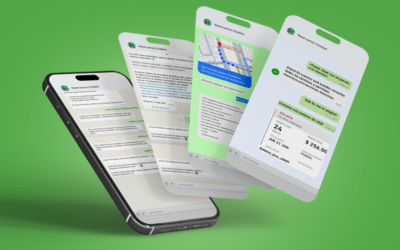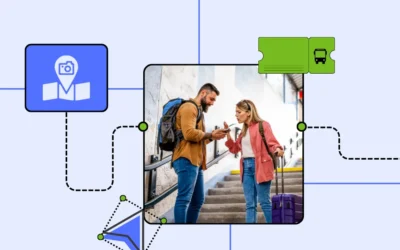Here are key tips from our experts to help bus companies optimize their performance during the high season.
The high season is crucial for bus companies, offering an opportunity to maximize revenue and attract new customers. However, this period also brings increased competition and variability in demand, making it essential to have a well-designed strategy that optimizes both the traveler’s experience and the company’s profitability.
Having a comprehensive approach that includes dynamic pricing, digital marketing, and a focus on customer satisfaction can make the difference between a highly successful season and one filled with challenges. To make the most of these opportunities, we’re sharing key tips from our experts to help bus companies optimize their performance during the high season.
Before diving into these strategies, it’s important to identify the main challenges to overcome to implement a comprehensive plan that addresses each critical aspect and achieves goals during peak demand periods.
What Are the Main Challenges to Overcome During the High Season?
Bus companies face significant challenges during the high season, particularly in managing demand and last-minute ticket sales. Saturation can complicate operational efficiency in the face of increased passenger volume, so it’s essential to have robust and scalable eCommerce systems that provide a frictionless experience.
An effective way to anticipate these difficulties is through data analysis, which helps identify destinations and schedules with higher search volumes or purchase intent. This way, companies can adapt their operations and resources based on expected demand, optimizing their responsiveness and enhancing customer satisfaction.
Historical data analysis is crucial for identifying demand patterns based on dates, destinations, and schedules. Companies can use this information to adjust ticket availability, create specific promotions, and adjust rates to attract travelers in advance. –Jose Luis Landaeta, Head of Customer Success at Reservamos SaaS.
According to Jose Luis, to develop an efficient high-season strategy, monitoring several key metrics, such as the average advance purchase time, route occupancy rates, the percentage of cancellations and changes, and customer satisfaction is essential.
Best practices include implementing quick ticketing systems for last-minute tickets, using dynamic pricing to adjust prices in real time, and improving customer service through chatbots or virtual assistants that address frequently asked questions.
It’s also important to measure eCommerce conversion rates, identify high-demand routes, and evaluate the effectiveness of marketing campaigns in driving traffic. These metrics provide valuable insights for refining strategies, ensuring efficient operations, and maximizing revenue.
A great opportunity for companies is to integrate data from all sales channels to optimize their omnichannel strategies. By unifying, storing, and organizing traveler interactions across each sales channel, companies can offer a uniform and personalized shopping experience at all touchpoints. –Jose Luis Landaeta, Head of Customer Success at Reservamos SaaS.
Steps for a High-Season Omnichannel Strategy
1. Plan Your Revenue Management Strategy
During the high season, travel demand is excessive, and bus companies often think that a revenue management strategy means keeping their prices static. However, an optimal revenue management strategy is based on analyzing opportunities to increase the base price, as long as it’s done intelligently.
Mitl García, Revenue Management Consultant at Reservamos SaaS, shares that a strategy that is often very useful is to increase the base price by 5%, especially on routes focused more on vacation destinations, such as beaches or popular tourist spots.
It’s vital to focus on these increases. However, each company should know its regions and know which markets are strong, which are weak, and where there is a need for an incentive, if necessary. My suggestion is to focus on the best routes or high-demand ones because these will have a guaranteed 100% occupancy. That’s where there is an opportunity to raise the base price. –Mitl García Martínez, Revenue Management Consultant at Reservamos SaaS.
Mitl recommends that companies prepare their revenue management strategies about three months in advance, although the lead time will depend on each company. Some companies, for example, load their strategies at the beginning of the year and adjust as they see changes. Others have a lead time closer to the high season.
Revenue management strategies help encourage travelers to purchase in advance. For high seasons, launching strategies early is very helpful because it enables you to measure how many people are buying in advance, thus better managing your offer or extra routes. –Mitl García Martínez, Revenue Management Consultant at Reservamos SaaS.
Mitl emphasizes that revenue management should not be confused with promotions but is an intelligent way of selling. Many factors prevent revenue management from being classified as a promotion.
A promotion will always have an expiration date, whereas revenue management strategies are not created to have an expiration date but to become a way of managing a company’s revenue in a smarter, more dynamic way. – Mitl García Martínez, Revenue Management Consultant at Reservamos SaaS.
With these strategies, bus companies are trying to encourage and create a new purchasing habit through advance purchases, the right channels, reaching the right customer, and offering the right price at the key moment.
2. Define Your Digital Marketing Strategy
During the high season, bus companies can maximize their sales with well-planned digital marketing strategies. It’s crucial to maintain continuous investment throughout the year, adjusting the budget based on demand: increasing investment during high-demand periods and reducing it during low periods.
Additionally, testing different types of advertising campaigns can provide insights into which ones work best and align with traditional search campaigns. By finding those campaigns that yield good results, companies can focus on maintaining them and making them an integral part of their marketing strategy.
Data analysis is an invaluable resource for personalizing campaigns and enhancing customer experience during peak demand. Thanks to historical data, companies can identify high-demand periods and the most requested routes or destinations.
Furthermore, analyzing auction statistics, such as impression volumes, clicks, and click-through rates (CTR), can identify areas for improvement. This information enables companies to tailor their campaigns to respond effectively to travelers’ interests and needs.
To foster traveler loyalty and generate long-term loyalty, bus companies should focus on the customer experience. Conducting surveys to measure the NPS helps understand users’ perceptions of the service, which is essential for implementing improvements. Offering benefits like e-wallets or loyalty points also helps encourage loyalty.
It’s also important to reinforce messages about the benefits of the service and spread them across all channels to strengthen communication. Another good practice is to conduct individual interviews with users to gain an in-depth view of their concerns and further personalize the experience.
3. Strengthen Digital Payment Security and Increase Conversion Rates
The integration of digital payment solutions improves the user experience and increases sales conversion during peak demand seasons.
Most digital payment solutions are designed to be used on mobile devices, making it easy for users to conduct transactions from their phones. This is especially important during the high season, as a large portion of traffic comes from mobile devices. –Pamela López, Head of Finance & Payments at Reservamos SaaS.
With over 450 million mobile phone users, according to Statista, mobile payments have become one of the cornerstones of e-commerce in Latin America and the Caribbean. Specifically, in 2020, the value of such transactions exceeded 38 billion USD in the region, and it is expected to surpass 100 billion by 2025.
Diversifying payment methods, according to Pamela, is also essential for providing convenient options that drive purchases, such as promotions for interest-free months or discounts with specific cards.
Digital payment solutions (like wallets) are often faster and easier to use than traditional payment methods. This reduces the time users spend in the payment process, minimizing frustration and increasing the likelihood of ticket purchases.
It’s important to consider that security is also a crucial part of offering a favorable online shopping experience. Therefore, companies should consider the following for this high-demand season:
- Two-Factor Authentication
You can offer the option of two-factor authentication for high-risk purchase attempts. This way, you give customers an option to proceed with their purchase while keeping the transaction secure. An example of this is the 3D Secure protocol, an online payment authentication system designed to enhance the security of electronic purchases made with credit or debit cards. It aims to prevent unauthorized transactions and combat fraud.
- Monitoring Suspicious Activities
Implement fraud detection systems that analyze transactions in real time. This includes using algorithms that identify unusual behavior patterns and notify the security team. Alternatively, you can adjust parameter settings based on expectations for the high season, such as a higher purchase frequency and a higher average ticket size.
- Ease and Clarity in Refunds
Establish a clear and straightforward process for refunds in case of cancellations or changes. This increases consumer trust and improves the shopping experience by offering greater flexibility.
Pamela mentions that companies should optimize the mobile experience since many users make purchases from their devices. A smooth payment platform with large buttons and simplified forms not only facilitates the purchasing process but also improves customer satisfaction by making each transaction quick and accessible.
The high season represents a valuable opportunity for bus companies to drive revenue and expand their customer base, provided they adopt a comprehensive strategic approach. By managing pricing intelligently, implementing digital payment solutions, and continuously improving the customer experience, companies can effectively adapt to demand challenges and ensure efficient and secure service.
Additionally, monitoring and analyzing real-time data enables for strategy adjustments to maximize profitability. By prioritizing traveler satisfaction and operational efficiency, bus companies can not only respond to the demands of the high season but also establish sustainable practices that strengthen their long-term market position.




